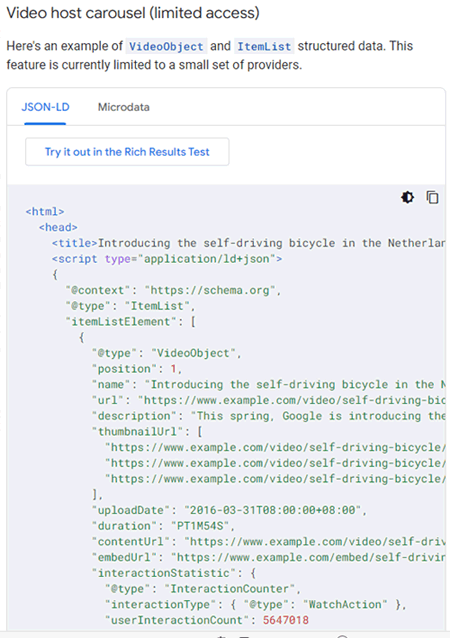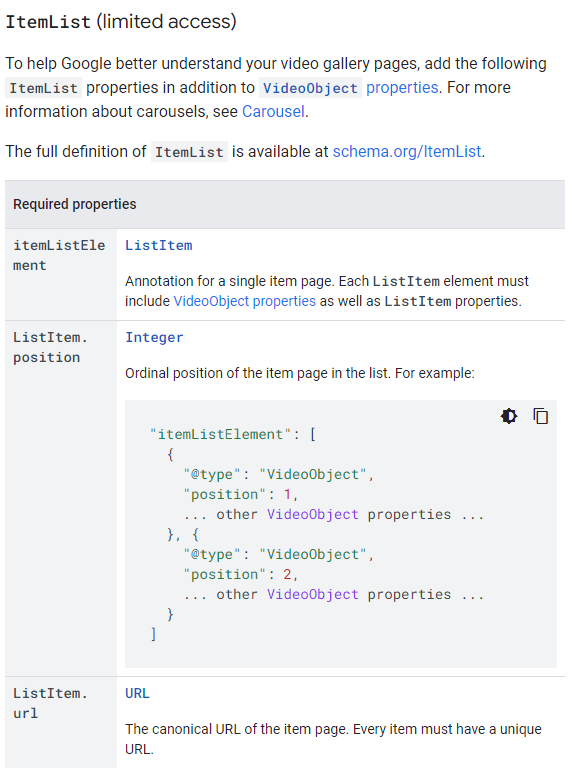
Google Discontinues Video Carousel Structured Data Experiment

Google has decided to discontinue the video carousel structured data experiment, citing limited usefulness for the digital ecosystem at scale. Learn more about Google's decision to end support for this feature.
Google has stopped supporting the video carousel (limited access) markup documentation and the related rich results. This decision was made after testing the structured data and finding that it wasn't effective on a larger scale. Site publishers who still use this specific structured data do not have to remove it, as it may still be valuable for other search engines. However, Google will no longer utilize it for rich results.
A paragraph has been taken out from the section of the documentation titled "Video with key moments in search results."
Enable users to easily navigate through your video gallery pages by adding ItemList structured data. Please note that this feature is currently only available to a select group of providers. Google Search may display a video host carousel for your site even without the need for you to manually add the structured data.
Google also removed the entire structured data example.
Screenshot Of Removed Structured Data Example
Screenshot of a webpage featuring a videoobject json-ld structured data example. the text and code snippets are clearly visible, intended to explain how to implement structured data for a video about self-driving bicycles.
Here is a screenshot of a webpage that showcases an example of videoobject json-ld structured data. In this image, you can see text and code snippets that are easy to understand. This example is designed to help you learn how to incorporate structured data for a video specifically about self-driving bicycles.
Google recently removed a link to the “Carousel guidelines” from the Guidelines section, where Google provides specific guideline documentation. Interestingly, the page that the link used to lead to still exists.
“Carousel guidelines”
Google removed the following phrase from the “Structured data type definitions” section:
“ItemList: Mark up pages with a list of videos to enable a video host carousel.”
And the entire section listing the recommended properties is now gone.
Screenshot Of Removed Recommended Properties Section
Screenshot of Google structured data documentation that was removed
Google Removed The Documentation:
Recently, Google made the decision to remove the documentation that was previously available. The documentation provided valuable information and guidance on how to use various features and functionalities.
Google’s developer changelog lists the following reasons why the documentation was removed:
“Removing video carousel (limited access) documentation
We have decided to remove the video carousel guidance from the video structured data documentation.
The reason for this decision is that after testing the video carousel markup with a group of site owners, we found that it wasn't very useful for the ecosystem at scale. However, you can still keep the markup on your site as it helps search engines and other systems better understand your web page.
Read the updated guidance for video structured data
Video (VideoObject, Clip, BroadcastEvent) structured data
View an archive of the old structured data documentation
Archive of Video (VideoObject, Clip, BroadcastEvent) structured data
Featured Image by Shutterstock/Koshiro K
Editor's P/S:
Google's decision to deprecate the video carousel markup is a significant development in the world of search engine optimization (SEO). This markup allowed website owners to highlight their videos in a prominent carousel format in search results. However, Google's testing revealed that this feature was not as effective as expected, leading to its removal.
The impact of this change is twofold. First, it means that website owners will no longer be able to use this specific markup to enhance their video content's visibility in Google search results. Second, it suggests that Google is placing less emphasis on video carousels as a means of presenting video content to users. This shift may have implications for how website owners prioritize video content creation and optimization strategies.













